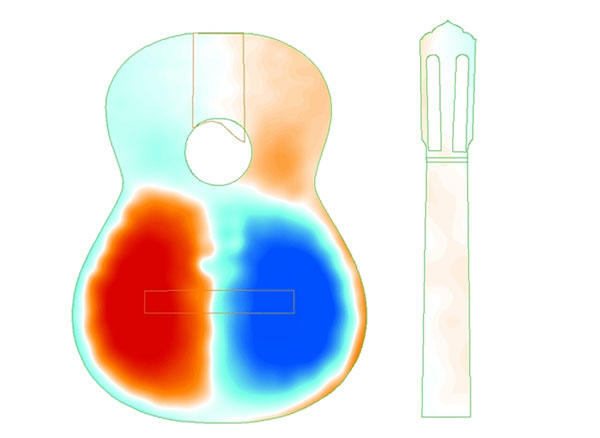THE GUITAR
My aim is to build an instrument that is responsive, easy to play, colourful, articulate, and powerful. In order to achieve this, I use a combination of traditional building techniques e.g. fan strutting or the Spanish heel construction and modern techniques e.g. composite materials (double top). The result is a guitar that delivers enough volume to be played on big stages while at the same time retaining a rich and warm traditional timbre.
The guitars are made by hand from the best quality materials I can find, using, among others cedar, spruce, rosewoods, ebony and mahogany.
If you are interested in my work please don´t hesitate to contact me.
media
Research
From early on in my guitar making career I tried to understand the physics behind the sound production of a guitar, and the more I learned the more complex the whole field became. I have now incorporated a wide range of measurement techniques into my daily workshop routine. As well as tapping, flexing and listening to each piece of wood and guitar part, I also measure their acoustical properties and frequency responses in different building stages.
This allows me to not have to work to specific dimensions, but to target specific masses and frequencies throughout the building process, resulting in a consistent sound quality from one guitar to the next, so a player can know what to expect when ordering one of my instruments.
In addition to relying on my own hearing, I use acoustical measurement techniques such as modal analysis and frequency response functions in order to extensively evaluate the result of experiments or small changes in the construction.
I occasionally venture out of the workshop, and have given several lectures on the subject of acoustical analysis and the research I have done in this area.
The WaveGuide
After a lot of designing, testing, measuring and fiddling around I’m proud to present my latest development: The new WaveGuide feature. The idea is to reach a main air resonance which is below E (82Hz) and thereby increasing the richness of the guitar’s tone by providing a higher fundamental tonal content.
A traditional Tornavoz brings the air resonance frequency down, but it also decreases the efficiency of the resonance greatly, which is counterproductive in most cases.
My WaveGuide design in contrast reduces the frequency without decreasing the efficiency of the resonance, by minimizing loss through turbulence at the edges of the tube / soundhole. I have carefully matched its dimensions to work with the resonances of my guitar.
Carefully choosing the material means I also managed to keep the mass of the waveguide very low, at about 7g, in order to minimize the influence on the top vibrations.
The result is a guitar that has a very rich, deep bass register, which is a great match with my usual clear and strong trebles. You can find a review of one of the first WaveGuide guitars here >
Biography

Dennis Tolz was born in 1985 and grew up in Berlin. He started playing the guitar at the age of fifteen and upon discovering the craft of guitar making his wish to become a guitar maker was born.
After finishing his A levels he decided to move to the United Kingdom, in order to study guitar making at the Newark School of Instrument Making. As the best student of his year he was awarded the Ashley Mark Publishing Prize of the Classical Guitar Magazine, U.K.
Returning to Germany in 2008, he decided to continue his instrument making studies at the University of Applied Sciences in Markneukirchen, graduating with the title of “Master” luthier. His work is influenced by, amongst others, the guitar maker Gernot Wagner who has shared with him his vast knowledge of double top guitars. Since 2012 Dennis has been continually developing his own double top guitar model and can count world renowned players including Giampaolo Bandini, Eva Beneke, John Dearman, Graham Devine, Arody Garcia, Thibaut Garcia, Rene Izquierdo, Ignacio Rodes, David Russell and Andrew Zohn among his customers.
Dennis currently lives and works in Kiel.
GET IN TOUCH WITH ME
TOLZ GUITARS is part of the family






















